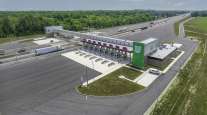Staff Reporter
Oregon Eyes Tolling Portland Region’s Interstates

[Stay on top of transportation news: Get TTNews in your inbox.]
Oregon is asking for public input on a congestion pricing plan to impose tolls on all lanes of Portland’s two interstates that would result in commercial trucks paying higher rates than passenger vehicles.
Oregon’s Department of Transportation seeks “to implement congestion pricing, which is a type of tolling that aims to improve mobility, travel times and reliability by charging a higher price during peak traffic periods of the day. This concept, also known as variable rate tolling, encourages drivers to consider using other travel options such as carpools or transit, or change their travel time to other, less congested times of the day, or not make the trip at all,” said Mandy Putney, director of ODOT’s Urban Mobility Office Strategic Initiatives.
Under consideration is tolling all travel lanes on Interstate 5 and Interstate 205 in the Portland metropolitan area, she said. Rates will be set based on congestion relief goals, revenue needs and public input.

Putney
“I-5 and I-205 carry most of the freight traffic in the region,” Putney remarked. “These major freight routes experience the highest levels of congestion and unreliable travel times. From 2015 to 2017, the Portland metro region’s population grew by approximately 80,000, and drivers experienced a 13% increase in hours of traffic congestion.”
No determination has been made yet on toll prices or what times of day drivers would be charged. Tolling could start at the end of 2024 on the I-205 corridor near the Abernethy and Tualatin River bridges in Clackamas County.
“Our planning models currently assume large trucks would be charged a higher toll rate, similar to other toll systems nationwide. Toll rates for all vehicle classes will be decided by the Oregon Transportation Commission about six months prior to the start of tolling,” Putney explained to Transport Topics.
The earliest tolling could begin for I-5 and other sections of I-205 is 2025. “ODOT is evaluating options to identify where tolling would begin and end. This initial analysis is happening now and then ODOT will conduct a more extensive environmental review,” Putney said.
Legislation enacted in Oregon in 2017 and 2021 directed the state transportation commission and ODOT to start charging tolls on I-5 and I-205 in the Portland region to reduce congestion and pay for transportation projects.
Revenue projections from the tolls are expected to come later this year for I-205 (with funds going to improve that roadway), and later next year in a Regional Mobility Pricing Project.
ODOT needs $510 million to maintain its current infrastructure and faces a shortfall since revenue from the state and federal gas tax (traditionally used to pay for its transportation system) is insufficient.
“The federal gas tax has not increased since 1993 and much of the region’s infrastructure is outdated and at risk of failing in a significant earthquake,” Putney said. “Tolling revenue will go toward safety and seismic improvements, multimodal initiatives to improve access to walking, biking, rolling and taking transit and overall maintenance of the transportation system.”
Jana Jarvis, president and CEO of Oregon Trucking Associations, has been following ODOT’s efforts and was invited to participate as a key stakeholder.
“Tolling our urban freeways in the Portland area to try to fund some expansion and maintenance costs is what our elected leadership is asking for,” Jarvis said, citing legislation that passed a few years ago paving the way for ODOT to finance some projects through tolling, especially new bridge construction.

Jarvis
Now, ODOT has expanded its desire beyond current construction of a new bridge on I-205 (to be partially financed from tolling) by looking into tolling the entire urban freeways system in the Portland metro region, she said.
In Oregon, expanding freeway capacity is difficult due to funding constraints and public opposition from environmentalists and others concerned about vehicle pollution.
It remains to be seen if public opposition will be raised against congestion-priced tolling. “It isn’t something that necessarily can easily be stopped,” Jarvis said.
When asked about the potential impact on truckers, Jarvis said there are many unknowns but acknowledged that the trucking industry in Oregon already experiences high state taxation.
“We are without a doubt the most expensive state in the nation with trucking taxes and fees. We’re at $30,000 and change for a Class A 80,000-pound truck, when the national average is closer to $15,000, and the second-highest state is California at $24,000 and change. So there’s big spread between first and second place,” she noted.
Oregon has almost as many freeway miles as neighboring Washington state, which boasts a population three times higher, she explained, adding that Oregon struggles with the expense of building and maintaining its road network with fewer inhabitants that pay taxes.
ODOT is accepting public comments via email (OHPManager@odot.oregon.gov) and on its website: www.oregon.gov/odot/Planning/Pages/Oregon-Highway-Plan-Update.aspx.
“ODOT is also working with people who could be negatively affected by a toll to better understand community needs and concerns,” Putney said.
Want more news? Listen to today's daily briefing below or go here for more info:



